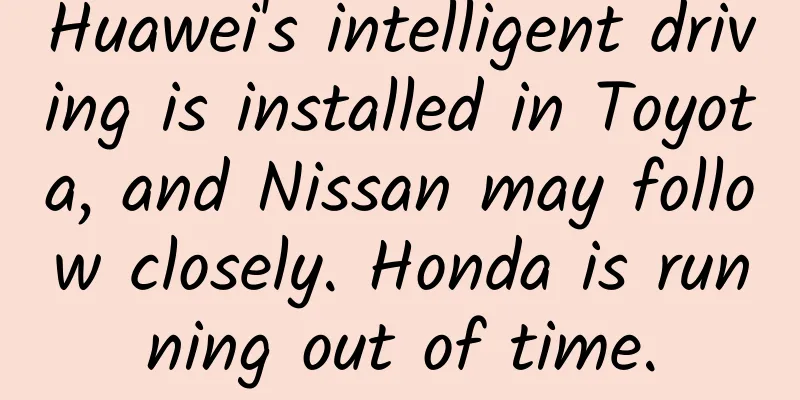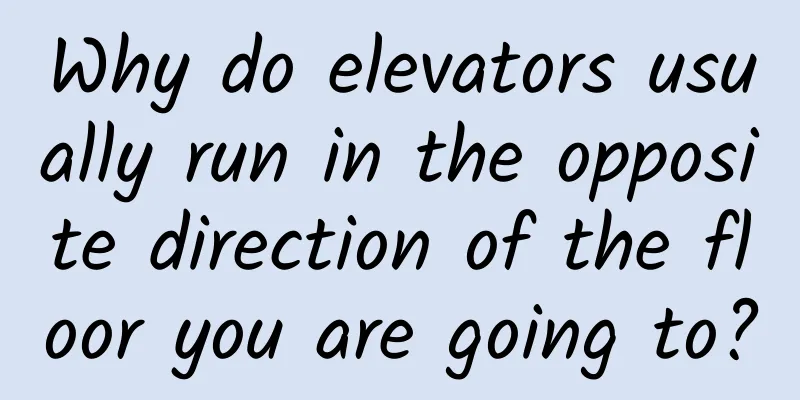Huawei's intelligent driving is installed in Toyota, and Nissan may follow closely. Honda is running out of time.

|
Toyota can't hold it back anymore. Recently, the news that Toyota will be equipped with Huawei's intelligent driving solutions has caused the public to re-examine this world's top automaker that was previously extremely resistant to electrification and intelligence. Some people think that this is Toyota's compromise with the Chinese market, while others say that this is Toyota's helpless move. The reason why it decided to enter the intelligent driving industry only at this time is simply that its own technical research and development capabilities are unable to support it. In any case, this is a big victory for Huawei. Toyota is the first major Japanese automaker it has won, and the cooperation between the two parties is based on Toyota's global models, which means it is not just aimed at China. This will definitely be the best endorsement for Huawei's future overseas expansion. Toyota is stubborn but rationalHuawei currently has three cooperation models in the automotive field, namely the parts model, the HI model where Huawei provides solutions, and the smart selection model where Huawei is deeply involved in product definition and sales. According to the above news analysis, Toyota may adopt the first model where Huawei's participation is relatively low. 91che believes that the reason why HI mode and smart selection mode were not selected may be based on three reasons: 1. Price. According to industry insiders, the full solution provided by Huawei itself costs 70,000 to 80,000 yuan. Previously, Xiao Yong, deputy general manager of GAC Aion, publicly stated that Huawei is a big-name supplier with high and uncontrolled prices, and GAC Aion and Huawei have basically no bargaining power in their cooperation. 2. Channels. Huawei is deeply involved in the smart selection model. Huawei uses its years of experience in To C to participate in the entire process from vehicle design to sales, and is most closely tied to car companies. However, Toyota has its own design and sales channels and does not need Huawei channels to sell cars on its behalf. 3. Cooperation. Toyota and Huawei already have a foundation for cooperation, but it is mainly focused on the field of smart cockpits. Not long ago, Toyota launched the ninth-generation Camry for the Chinese market, which is equipped with a car system jointly built with Huawei. It is precisely because of the addition of Huawei Hicar that the ninth-generation Camry has been labeled "smart" and has become one of the mainstream smart models. In addition, as the strongest of the three Japanese giants, Toyota's sales in China have actually been under tremendous pressure in recent years. In February this year, Toyota's car sales were 83,300 units, a year-on-year decrease of 35.7%. Among them, the high-end brand "Lexus" decreased by 9.6% to 9,200 units. The situation of the other two Japanese giants is now even more muddy. Honda's sales were 45,498 units, a year-on-year decrease of 38.6%; Nissan's sales were 41,824 units, a year-on-year decrease of 30.3%. From January to March this year, Honda's terminal automobile sales in China were 206,900 units, down 6.11% year-on-year. Among them, GAC Honda's cumulative sales were 108,400 units, down 8.11% year-on-year; Dongfeng Honda's cumulative sales were 98,500 units, down 3.80% year-on-year. Nissan Motor's cumulative sales in China, including passenger cars and light commercial vehicles, were 167,300 units, up 3.3% year-on-year. It is not difficult to see from the sales volume that the three Japanese giants have lost a lot of competitiveness due to their continuous retreat in China. However, China has a large passenger car market potential. If they do not want to completely disappear from the public's sight, "change" is the only way out. 91che believes that with the launch of various promotional policies, this year will be a big year for automobile consumption, and the market is expected to continue to show strong growth potential, especially in the field of new energy vehicles. Therefore, it is not difficult to understand why Toyota is seeking cooperation with Huawei, but for Nissan and Honda, will they follow suit or stick to it? Will Nissan follow?Before Huawei was revealed to be cooperating with Toyota, the most popular candidate for Huawei's cooperation with a Japanese joint venture brand, apart from Toyota, was Nissan. At the end of March, Nissan Motor announced a new four-year strategic plan, "The Arc", which aims to further enhance corporate value and global competitiveness by comprehensively improving product strength, accelerating electrification transformation, innovating R&D and production methods, and deepening digital technology applications and strategic cooperation. This plan includes two key goals. First, Nissan will achieve customized regional strategies and accelerate electrification transformation by balancing the portfolio of electric vehicles and internal combustion engine models, increasing sales in major markets, and strengthening financial discipline. It is expected that by fiscal 2026, global annual sales will increase by 1 million vehicles and operating profit margin will increase to more than 6%. The second part focuses on promoting electrification transformation and ensuring long-term profitable growth by building strong partnerships, enhancing the competitiveness of electric models, and expanding innovation and new revenue growth points. Nissan expects to generate potential revenue of 2.5 trillion yen from new businesses by fiscal 2030. Behind Nissan's grand vision are complaints about the car-machine system. According to relevant data, in March 2024, the Nissan Teana complaint index was 169.8, a month-on-month increase of 338.76%, ranking third in the mid-size car complaint list. Judging from the complaint feedback, the concentrated outbreak of the car-machine system upgrade problem is the real user demand for the surge in Teana complaints. In other words, Nissan has increased its emphasis on electrification and its need for external cooperation. In the Chinese market, upgrades to intelligence and electrification are particularly important. The imperfections of Nissan's own car-machine systems need to be urgently addressed. There is reason to look forward to the relationship between Huawei and Nissan. Earlier this year, Dongfeng Motor and Huawei reached a strategic cooperation, committed to the development of intelligent field. According to the news at that time, the cooperation mode is HI mode, Huawei will jointly develop with Dongfeng Motor, and deeply participate in everything from R&D to software and hardware installation, providing manufacturers with complete autonomous driving and intelligent cockpit full-stack solutions. On March 7, You Zheng, member of the Standing Committee of the Party Committee and deputy general manager of Dongfeng Motor Group Co., Ltd., said that Dongfeng is actively promoting the participation of FAW in Huawei's intelligent vehicle solution business, and it is expected that there will be a preliminary conclusion by June 2024. At the same time, Dongfeng Motor will not give up the brand and follow the smart car route. The cooperation with Huawei's car BU is a technical cooperation, not the traditional HI model. A number of cooperative models will be launched at the end of 2024 and in 2025. As a brand under Dongfeng Group, the possibility of cooperation between Dongfeng Nissan and Huawei is greatly increased. If the two sides cooperate, Huawei will undoubtedly provide strong technical support for its development in the field of intelligence. This not only meets the strategic cooperation needs of Dongfeng Group and Huawei, but also fits Nissan's customized regional strategy in the Chinese market. With this as a starting point for cooperation, the imagination space for cooperation between the two sides will be greater. Although the answer to this rumor is ultimately Toyota, it is not completely impossible for Nissan to cooperate with Huawei. As You Zheng said, before there is a preliminary conclusion in June 2024, it is better to let the bullets fly for a while. Whether Nissan will follow Toyota after June is still worth looking forward to. Why Honda is more likely to hold onAlthough it was called "the best car under 500,000 yuan" by the Internet celebrity Xiao Suanrou, Honda has begun to be at a loss and even helpless in the market. As the most conservative of the three Japanese companies, Honda's response to electrification and intelligence is the slowest, and it has not taken any more actions even after the sales volume plummeted. Since its sales in China reached a peak of 1.627 million vehicles in 2020, Honda began to decline all the way, and has failed to stop falling for three consecutive years. As mentioned above, in March this year, Honda recorded the largest year-on-year decline since July 2023. China's consumer environment has changed, and the main car-buying group is gradually getting younger. According to the AlixPartners report, compared with the power performance and noise control that traditional brand audiences value, China's new generation of car users value the intelligence and technology of cars more. Compared with China's new power brands, Honda, which sticks to tradition, can no longer use its brand advantages to attract young consumers. However, Honda still has blind confidence in its own brand value. In the recent price war, Honda has chosen to increase the prices of some models to cope with market fluctuations instead of reducing them. For example, in the Honda Fit and Style new cars launched in March this year, the starting price of the Style Mugen version is set at 157,900 yuan, while the starting price of the Fit Mugen version is 97,800 yuan. This may not be very attractive to the increasingly younger Chinese consumers. Honda has been considering reducing its production capacity in China due to the continuous decline in sales. It is reported that Honda has planned to reduce its automobile production capacity in China by 20%. In fact, by the time Honda realized its disadvantageous position and began to actively change, the market competition had already changed. None of its countermeasures hit the target. Although Honda has previously released a long-term plan for new energy transformation, according to the plan, Honda will stop launching new fuel models in China from 2027, and strive to achieve full electrification of models sold in China by 2035. Although Honda's full electrification goal in China is five years ahead of its global plan, at a time when domestic brands are relatively mature in intelligence and Toyota and Nissan are constantly stepping up their layout, Honda's goal still seems a bit slow. So, will Honda choose to cooperate with Huawei like Toyota? 91che speculates that the possibility is not high, which is determined by Honda's conservative genes. Honda has tried intelligent in-vehicle systems, but its research and development in this area has long lagged behind the mainstream. Take Honda's mid-size sedan Accord as an example. As a mid-range model, it only has an 8-inch touch screen in-vehicle system that only provides voice control functions for telephone and multimedia systems. This is far from the domestic multi-screen, multi-functional human-computer interaction, and car-home interconnection intelligence. It is well known that it is difficult to make up for the shortcomings of backward intelligent research and development in a short period of time. Cooperation with Huawei requires cost considerations and sincere cooperation from both parties. Honda's insistence is influenced by both external factors, its passive position, and its own genes. Reducing production and raising prices to maintain its brand image is undoubtedly a bad move. Honda does not have much time left in the Chinese market. As a winner of Toutiao's Qingyun Plan and Baijiahao's Bai+ Plan, the 2019 Baidu Digital Author of the Year, the Baijiahao's Most Popular Author in the Technology Field, the 2019 Sogou Technology and Culture Author, and the 2021 Baijiahao Quarterly Influential Creator, he has won many awards, including the 2013 Sohu Best Industry Media Person, the 2015 China New Media Entrepreneurship Competition Beijing Third Place, the 2015 Guangmang Experience Award, the 2015 China New Media Entrepreneurship Competition Finals Third Place, and the 2018 Baidu Dynamic Annual Powerful Celebrity. |
>>: Apple knows everything about you and me
Recommend
Analysis of oCPC delivery plans and strategies in the medical beauty industry!
Today let’s take a look at an oCPC case in the me...
Is it funding or technical issues that make it so difficult to return to the moon 50 years after the Apollo program?
For a long time, doubts about the Apollo manned m...
What are the reasons for the poor results of Baidu’s bidding promotion?
Customers often visit the official website to inq...
What short video methods did the popular Li Ziqi use?
The rise of short video media has driven traffic ...
Where are hybrid cars headed?
On June 13, the Legislative Affairs Office of the...
How to write text message copy? Improving copywriting skills for SMS marketing
On the one hand, a lot of money and energy are in...
How does Taobao Affiliate make money through promotion? How does Alimama Taobao Affiliate Promotion make money?
How does Taobao Alliance make money? Regarding th...
2016 e-commerce Double Eleven tutorial | The most comprehensive prepaid deposit promotion strategy in history
Soon to come is China’s annual e-commerce shoppin...
“Health from Eating” Series | National Fitness Day: How can people who exercise eat scientifically?
...
Today's prosperity is what you wish for! Tribute to the older generation of aerospace people
As the bright Chinese space station passed throug...
Are you one of these 730,000 car owners? Guangqi Honda's sales in 2017 exceeded 730,000
According to official information from GAC Honda,...
The ancient bridge with 10 cm deep ruts was once a water and land wharf on the Grand Canal.
The plum rains have cleared, and the summer breez...
Case Study: Review of Tmall’s 21-Day Vitality Plan
From the news on April 10th that Yi Yang Qianxi w...
Going back to the ancient times when there was no Internet, what was the game of "All or Nothing" about?
The recent release of the movie "All or Noth...
The camel, the "ship of the desert", was actually the most valuable pioneer before the beginning of the great voyages of discovery!
If you are trekking in the desert or in harsh env...









